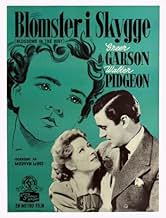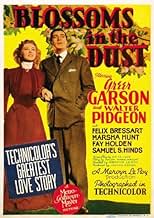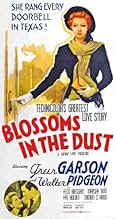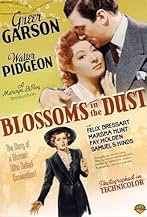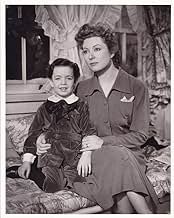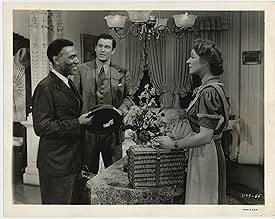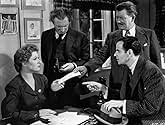IMDb-BEWERTUNG
6,9/10
2451
IHRE BEWERTUNG
Nach dem Verlust ihres kleinen Sohnes wendet sich Edna Gladney gegen die unlauteren Gesetze, die Kinder diskriminieren, deren Eltern unbekannt sind, und eröffnet ein Waisenhaus für diese Kin... Alles lesenNach dem Verlust ihres kleinen Sohnes wendet sich Edna Gladney gegen die unlauteren Gesetze, die Kinder diskriminieren, deren Eltern unbekannt sind, und eröffnet ein Waisenhaus für diese Kinder.Nach dem Verlust ihres kleinen Sohnes wendet sich Edna Gladney gegen die unlauteren Gesetze, die Kinder diskriminieren, deren Eltern unbekannt sind, und eröffnet ein Waisenhaus für diese Kinder.
- 1 Oscar gewonnen
- 3 Gewinne & 4 Nominierungen insgesamt
Charles Arnt
- G. Harrington Hedger
- (as Charlie Arnt)
Patricia Barker
- Tony
- (as Pat Barker)
Empfohlene Bewertungen
Much of this movie is fiction, but the fact remains that Edna Gladley was a pioneer in the field of nursery care and adoption and her work to strike the description "illegitimate" from birth certificates as well as insure that these children could inherit from their adoptive parents has changed many lives for the better. Edna was born in Milwaukee; her father died when she was very young; she never had an adopted sister who was herself illegitimate. Because Edna suffered from respiratory disease she was sent to Fort Worth, Texas, when she was seven years old to live with her aunt and uncle. She and her husband Sam were married in Gainseville after which they moved to Wolfe City where they bought a mill to manufacture Gladiola brand flour. They were childless.
Edna began her work in helping impoverished and homeless children soon after moving to Wolfe City where she started a crusade to clean up the county poor farm during which she arranged to have homeless children moved to the Morris Children's Home and Aid Society in Fort Worth. She joined the Society's Board in 1910. She then made trips to settlement houses in Chicago and New York City to study their methods; when she returned she set up a day nursery for working mothers (the movie has her setting up the nursery first when in fact this happened seven or eight years after she became involved in child welfare issues).
As in the movie, Sam's business failed in 1924 whereupon they moved to Fort Worth where Edna continued her work in child welfare. In 1927 she was named superintendent of the Texas Children's Home and Aid Society. Sam died in 1935 after rebuilding his business. Edna spent the rest of her life advocating for children, concentrating on placing homeless and abandoned children with adoptive families. She also expanded the Society to provide health care for unwed mothers and an adoption service for their children. The Society later bought a maternity hospital that it named the Gladney Center.
I loved Greer Garson in this movie, she is strong, brave and gracious. I just wish the director and producers of this movie had used a script that portrayed the real life of Edna Gladney rather than resorting to the fictitious adopted sister who kills herself and inventing a non-existent son who dies in an accident to explain her motives. Edna was her own person who was genuinely involved in her life's work from her early 20s until she died in 1961 -- the movie didn't need these made-up people to explain why she became involved in child welfare issues.
Edna began her work in helping impoverished and homeless children soon after moving to Wolfe City where she started a crusade to clean up the county poor farm during which she arranged to have homeless children moved to the Morris Children's Home and Aid Society in Fort Worth. She joined the Society's Board in 1910. She then made trips to settlement houses in Chicago and New York City to study their methods; when she returned she set up a day nursery for working mothers (the movie has her setting up the nursery first when in fact this happened seven or eight years after she became involved in child welfare issues).
As in the movie, Sam's business failed in 1924 whereupon they moved to Fort Worth where Edna continued her work in child welfare. In 1927 she was named superintendent of the Texas Children's Home and Aid Society. Sam died in 1935 after rebuilding his business. Edna spent the rest of her life advocating for children, concentrating on placing homeless and abandoned children with adoptive families. She also expanded the Society to provide health care for unwed mothers and an adoption service for their children. The Society later bought a maternity hospital that it named the Gladney Center.
I loved Greer Garson in this movie, she is strong, brave and gracious. I just wish the director and producers of this movie had used a script that portrayed the real life of Edna Gladney rather than resorting to the fictitious adopted sister who kills herself and inventing a non-existent son who dies in an accident to explain her motives. Edna was her own person who was genuinely involved in her life's work from her early 20s until she died in 1961 -- the movie didn't need these made-up people to explain why she became involved in child welfare issues.
Just wonderful - powerful enough to move anyone. The fact that this is a true story makes it even more remarkable. Greer Garson deserved the nomination for Best Actress - she covers decades in the life of Edna Gladney who varies from romantic girl to society hostess to earth-shaker.
This is a wonderful, heart warming, fantastic movie to see. Greer Garson is splendid in this movie, and it will really touch your heart. This movie has a special meaning for me, as I was adopted from the famous Edna Gladney Home in Ft. Worth, Texas. Edna Gladney personally handed me to my new adoptive parents. She called them that morning and told them she had the most beautiful baby girl ready for them to bring home. I have watched this movie so many times, and wow, what a movie! Just love Greer Garson, she is a splendid and talented actress. One more note, if it hadn't been for Edna Gladney and her crusade, I most likely would have been an orphan. She did a lot for unwanted babies.
"Blossoms in the Dust" is a biographical message movie about the plight of illegitimate children in the early 20th century and the stigma they faced from the get go because of the sins of their parents.
This film might as well have been called "The Greer Garson Show," because it is all about her. She plays Edna Gladney, a woman who made a crusade of finding loving adoptive homes for outcasts. She's lovely and committed in the role, and earned a Best Actress Oscar nomination for it. I believe this was the first time she was paired with Walter Pidgeon, and he's pretty good too as a cocky Texan who charms her and then marries her, but he very definitely stands in Garson's shadow for most of the film.
Cedric Gibbons, Urie McCleary, and Edwin B. Willis won the Oscar for their color art direction, and this is one of the rare films from the early days of Technicolor that looks gorgeous rather than garish. The film was also nominated for Best Picture and Best Color Cinematography.
Grade: B+
This film might as well have been called "The Greer Garson Show," because it is all about her. She plays Edna Gladney, a woman who made a crusade of finding loving adoptive homes for outcasts. She's lovely and committed in the role, and earned a Best Actress Oscar nomination for it. I believe this was the first time she was paired with Walter Pidgeon, and he's pretty good too as a cocky Texan who charms her and then marries her, but he very definitely stands in Garson's shadow for most of the film.
Cedric Gibbons, Urie McCleary, and Edwin B. Willis won the Oscar for their color art direction, and this is one of the rare films from the early days of Technicolor that looks gorgeous rather than garish. The film was also nominated for Best Picture and Best Color Cinematography.
Grade: B+
Blossoms in the Dust is a Excellent Powerful Moving True Story Drama. As others have noted--since it is a true story film--this is an added plus. One reason to see this film alone is Greer Garson. Her acting is superb. She is one of my all time favorite actress's of yesteryear. Walter Pidgeon is wonderful also. Some others that have commented on this film have said that it was fine but their one negative was that the phrase "Darling" was used to much. Yes this is true--but hey folks this was a very common popular word used a lot in the 30's & 40" films.-No big deal--at least it is clean & for all family member's. This great story is basically about Edna-played by Garson who marries Sam-played by Pidgeon-an operator of a wheat mill. They have a son who is killed when he is young. Edna discovers by chance how the law treats children who are without parents & decides to do something about it. She opens a home for foundlings & orphans & begins to place children in good homes-despite the opposition of conservative citizens-narrow minded back them of this subject matter-who would condemn illegitimate children being born out of wedlock. She them fights for them through the court. This is a great classic film.
Wusstest du schon
- WissenswertesThe child who portrayed Tony in the movie was a 4-year-old named Pat Barker. It was only when Pat came to Fort Worth to celebrate the movie's premiere that the world discovered Pat was really Patricia.
- PatzerSam and Edna celebrated their first anniversary in 1907, which means they married in 1906. But early in the film - when both are still single - they danced to "Let Me Call You Sweetheart", which was not published until 1910.
- Crazy CreditsOpening credits prologue: This is the story of a great woman, and of the great work she is doing for humanity. Her name is Edna Gladney, and she lives in Fort Worth, Texas. We dedicate this picture to her. Let us first take you back to a certain household in Wisconsin at the beginning of the century -
- VerbindungenFeatured in The 69th Annual Academy Awards (1997)
- SoundtracksLullaby
(uncredited)
Music and Lyrics by Herbert Stothart and Earl K. Brent
Sung by Nadine Conner and Irene Crane in opening credits
Top-Auswahl
Melde dich zum Bewerten an und greife auf die Watchlist für personalisierte Empfehlungen zu.
- How long is Blossoms in the Dust?Powered by Alexa
Details
- Erscheinungsdatum
- Herkunftsland
- Sprache
- Auch bekannt als
- De corazón a corazón
- Drehorte
- Produktionsfirmen
- Weitere beteiligte Unternehmen bei IMDbPro anzeigen
- Laufzeit1 Stunde 39 Minuten
- Seitenverhältnis
- 1.37 : 1
Zu dieser Seite beitragen
Bearbeitung vorschlagen oder fehlenden Inhalt hinzufügen

Oberste Lücke
By what name was Blüten im Staub (1941) officially released in India in English?
Antwort

